Catwoman made her initial appearance in the very first issue of Batman’s solo title in 1940 as “The Cat.” A cat-burglar named Selina Kyle, she quickly became a popular member of Batman’s rogues’ gallery, and the most prominent female member of same.
The main difference between Catwoman and Batman’s other foes, like the Joker, the Penguin, and so on, was that there was a certain amount of sexual tension. Mostly that was expressed in the middle of the 20th century as good old-fashioned sexism, as Batman treated Catwoman with more respect and a lot of drooling because she was a girl.
Then Catwoman appeared in the 1966 TV series starting Adam West, and her popularity as a character skyrocketed.
Portrayed by Julie Newmar in the first two seasons of the show, by Lee Meriwether in the movie released between those two seasons, and by Eartha Kitt in season three, Catwoman was the unexpected hit in the TV series rogues’ gallery. Cesar Romero, Frank Gorshin, and Burgess Meredith appeared in multiple episodes each of the first season, but Newmar only appeared in one two-parter. She created enough of an impression that the character was used in the movie alongside the big three (re-cast due to Newmar’s unavailability), and she then went on to make more appearances in season two than anyone not actually listed in the opening credits.
In the comics, Catwoman was never a killer, and never 100% evil, but always in it mainly for the money. Based in part on Jean Harlow, she was someone to whom Batman was attracted, whom he tried to reform rather than simply capture, and whom he would sometimes let escape.
When DC rebooted their heroes in the 1950s and 1960s, with new versions of Flash and Green Lantern, they established that the older heroes were fictional—at least until the Golden Age Flash met up with Barry Allen in 1961’s infamous “Flash of Two Worlds” in The Flash #123, making it an alternate timeline. It was later established that the Golden Age, or “Earth-Two,” versions of Batman and Catwoman that were active during the second World War eventually married after Selina Kyle retired.
As time went on, Batman and Catwoman’s relationship became more and more complicated. In 1987, Frank Miller and David Mazzucchelli’s retelling of Batman’s origin in the “Batman: Year One” story in Batman #404-407 gave Kyle’s background as a sex worker with an affinity for cats. This led to Catwoman’s first miniseries, by Mindy Newell and J.J. Birch in 1989, and in the 1990s, Catwoman got her own monthly series, initially by Jo Duffy and Jim Balent, and she has had her own titles on and off ever since. She’s been portrayed as more of a morally dodgy hero, or an antihero, since getting her own series two and a half decades ago, and her origin has been reinterpreted and retold many times, including connections to the Gotham City mob in The Long Halloween by Jeph Loeb and Tim Sale. Recent reboots of DC have made Batman and Catwoman into an actual couple, complete with a marriage proposal in Batman #32 released late last year.
The next time after the Adam West series that the character appeared onscreen was in 1992’s Batman Returns, with Michelle Pfeiffer playing a radically different version of Selina Kyle. A mousy secretary who is killed after discovering corporate espionage by her boss, she’s seemingly revived by a bunch of cats and becomes an Olympic-level athlete with a taste for revenge. She’s seemingly killed along with that boss, but is seen in the closing shot of the movie, implying that she’d appear again.
While Tim Burton was removed from the Bat-franchise after Batman Returns, he was nonetheless interested in doing a Catwoman spinoff. Initially, it was to be directed by Burton, written by Returns co-writer Daniel Walters, and Pfeiffer was to reprise the role. But it languished in development hell, Burton and Pfeiffer moved on, and eventually—after both Ashley Judd and Nicole Kidman were announced as playing the part—a movie called Catwoman was released in 2004 starring Halle Berry, playing a woman named Patience Phillips, who is transformed into Catwoman. While Walters wrote a script, which he turned in to Warner Bros. in 1995, none of it was used, with numerous hands working on it (including John Rogers, creator of Leverage and developer of The Librarians, and also a former comic book writer). French visual effects guru and second-unit director Pitof was brought in to helm it, only his second feature film in the director’s chair.
To call this movie a flop undersells it. It swept the Golden Raspberry Awards, with Berry being one of only half a dozen people to win both an Oscar and a Razzie (the former for Monster’s Ball in 2001). It has been pretty universally panned. And it never made back its budget, even including international receipts.
Despite this, the character has continued to be popular in the comics and on screen. Kyle appeared in Christopher Nolan’s The Dark Knight Rises, the conclusion of his late 2000s Bat-trilogy (which we’ll get to in this rewatch in a month or two), played by Anne Hathaway, and a younger version of Kyle is played by Camren Bicondova in the FOX TV series Gotham. The character has also been seen extensively in animation, going all the way back to Filmation’s two Batman series in the late 1960s and mid-1970s (voiced by Jane Webb and Melendy Britt, respectively), and also regularly appearing in Batman: The Animated Series (voiced by Adrienne Barbeau), The Batman (voiced by Gina Gershon), and Batman: The Brave and the Bold (voiced by Nika Futterman).
“You’re not a hero, you’re just a little girl playing dress-up”
Catwoman
Written by Theresa Rebeck and John Brancato & Michael Ferris and John Rogers
Directed by Pitof
Produced by Denise Di Novi and Edward L. McDonnell
Original release date: July 23, 2004
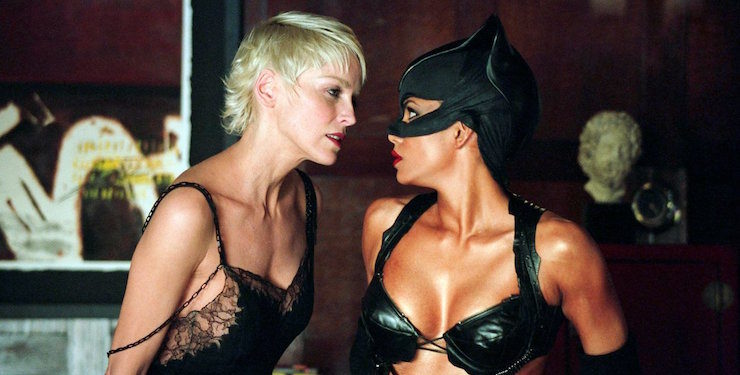
Patience Phillips is an artist who does design work for a cosmetics company, Hedare Beauty. Hedare is about to release a new skin cream, and they’re also unveiling a new model. Owner George Hedare announces that his wife, Laurel, will be stepping back from her role as spokesmodel for Hedare.
Hedare is also displeased with Phillips’s latest designs, saying it wasn’t what he wanted. Phillips is too much of a shrinking violet to tell Hedare that she gave him what he asked for. Laurel talks him out of firing her, and she has one day to fix it.
That night, she sees a gray cat on the ledge outside her apartment. She climbs out to rescue the moggy, but then the cat disappears—and Phillips is stuck standing on an unstable air conditioner. Detective Tom Lone sees this, assumes she’s a jumper, and dashes up to save her. He breaks into her apartment and pulls her in—where they both see the cat sitting in Phillps’s apartment like she owns the place. Lone didn’t believe there was a cat until he saw her, and he apologizes. She rushes off, as she has to get to work, but drops her wallet.
As she plugs away at the artwork, Lone shows up at her office and gives her the wallet back, and also asks her out to coffee the next day. Encouraged by her coworkers, she accepts.
Burning the late-night oil, Phillips gets the art done at 11:43. Unfortunately, all the messenger services are closed, and so she has to get it to the manufacturing plant herself.
When she arrives, she overhears Dr. Slavicky, the scientist who developed the new face cream, getting cold feet. He’s okay with the headaches and addictive properties of the cream, but if women stop using it, their skin gets all yucky. He’s okay with pain and addiction, but draws the line at looking ugly. Swell guy.
Phillips overhears this, and security is all over her. They shoot at her and lure her into a spillway, which they then flood. Phillips drowns, only to be rescued by the gray cat and several dozen more cats, who manage to pull her from the river and revive her. She stumbles back to her apartment on foot, moving like a cat.
She wakes up sleeping on a shelf, having apparently bathed herself and changed clothes. (The clothes she drowned in are in a heap under the broken window.) There’s a message on her answering machine from Lone—she missed their coffee date. She has no memory of anything that happened the previous day. The gray cat is there, and she has an address on her collar.
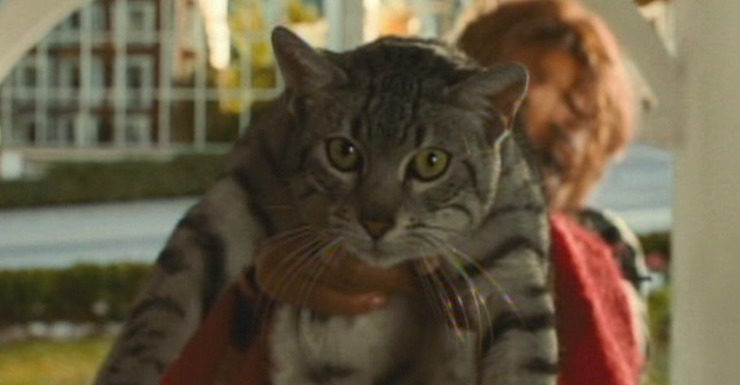
Going there, Phillips meets Ophelia, your prototypical crazy cat lady, who explains that the gray cat—whose name is Midnight—is an avatar of Bast, the Egyptian god who has endowed various women over the centuries with special abilities after resurrecting them. She shows Phillips clippings and photos of other “catwomen” throughout the ages. (One of the pictures looks a lot like Selina Kyle in Batman Returns….)
When she shows up at work, finally, Hedare yells at her for disappearing and not knowing where the art is. Phillips is timid at first, then mouths off at Hedare, who fires her for her impudence. The long-suffering staff all applaud her.
She tracks down Lone, who’s giving a talk to some schoolkids. She gives him a cup of coffee with “sorry” written on it. They go out to the basketball court and the kids encourage Lone and Phillips to play one-on-one. Phillips kicks his ass at ball.
Phillips becomes more and more outgoing, changing her hair, actually wearing the leather outfit a coworker got her, stopping a jewel heist just so she can steal a jewel herself, and tracking down the guys who killed her. She finds one at a club, and he reveals that they were just under orders.
She goes to the manufacturing plant only to find Slavicky’s dead body. A maintenance worker sees her standing over the body, and he sounds the alarm. The press now believes that some “Catwoman” killed Slavicky.
Catwoman then goes to the Hedare mansion, where Laurel lays the blame for Slavicky’s murder on her husband, from whom she is long estranged. Laurel tells Catwoman where to find Hedare and his new model. She goes to the play they’re attending, and torments Hedare, but is interrupted in her attempt to kill him by the cops—including Lone. They fight backstage, and Catwoman gets away.
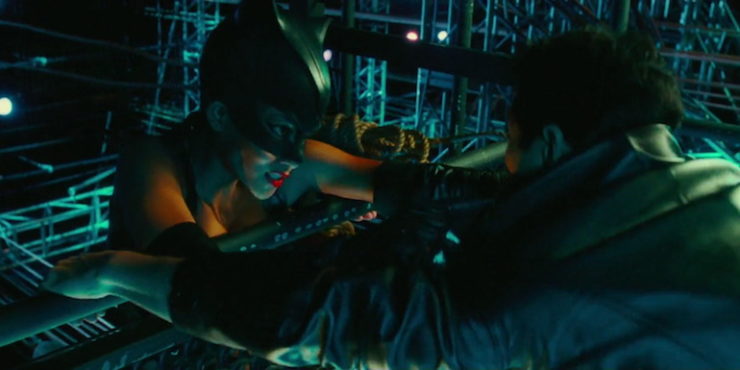
Back at the precinct, Lone realizes that the handwriting on a bag left behind at the jewelry heist (which contained all the jewels the other thieves intended to steal, save for the one gem Catwoman was after) is a close match with the writing on the cup Phillips gave him. After another date with Phillips, he brings evidence from her apartment to the lab, and confirms that Phillips is Catwoman.
Laurel contacts Catwoman and summons her to the mansion. It turns out that Laurel is the real bad guy here. Hedare knew nothing about the face cream’s negative side effects, nor one other salient point: consistent exposure to the cream turns the skin marble hard. Catwoman arrives to find Hedare’s body, his face scratched, and his body full of bullets from a weapon that Laurel tosses at Catwoman right before she calls security and starts crying.
Catwoman is now accused of Hedare’s murder, and Lone shows up at her apartment to arrest her. Heartbroken, she goes quietly, but also tells him during the interrogation that things are not what they seem. She reminds him that when they first met, all the evidence pointed to her being a jumper, but she was really a person trying to rescue a cat.
Midnight shows up in her cell, squeezing through the bars. She realizes that she can do likewise, and escapes by squeezing herself through the bars. She then confronts Laurel, but her marble skin makes her a difficult opponent. Eventually, though, Catwoman is triumphant when Laurel falls out a high-story window—even hard skin won’t save you from that kind of fall.
Catwoman goes free, exonerated of her accused crimes, but she refuses to get into a relationship with Lone, as she needs to be free to do as she pleases. Y’know, like a cat.
“What are you? A hero? A thief? A murderer?”
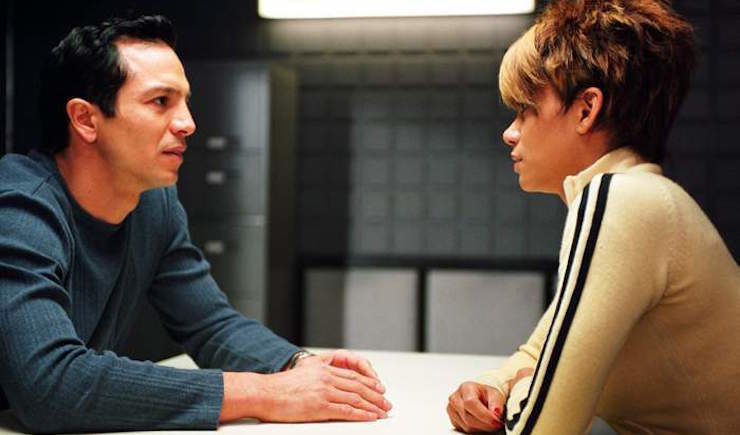
I never actually saw this film before. I chose to believe the hype and did not see it in theatres, nor did I ever get around to watching it on home video until this week.
Here’s the thing: it’s not as bad as everyone says it is.
This is mostly because it’s not really possible for it to be as bad as everyone says it is. I mean, this is a movie that has a decent budget, camerawork that is done in a professional manner, and actual good actors. Not that this is the best performance by any of them, but still, at least they’re capable.
All this is damning with faint praise, of course. While the movie isn’t as dreadful as everyone said, it also isn’t, by any stretch of the imagination, good.
Let’s start with something that rarely gets play: holy crap, the CGI is horrendous. Early 21st-century CGI was always hit-or-miss, but it’s fascinating to look at Spider-Man, then Daredevil, then Hulk, then Catwoman—the movies were released in that order, yet the CGI work for each one is noticeably worse than the previous one, with Catwoman being the worst offender, as the CGI version of Catwoman is awkward and stilted. It looks more like a video game than a person, it’s just horrible.
The plot shines a bigger light on the fact that Tim Burton evinced no interest in the comics version of Catwoman, as the character Michelle Pfeiffer played bore no resemblance to any of the versions of Selina Kyle we’ve seen in four-color form since 1940. And this movie takes as its inspiration, not any of the comics versions of Catwoman, but instead the 1992 Bat-film, as Patience Phillips’s storyline follows the exact same beats as Pfeiffer’s version of Kyle.
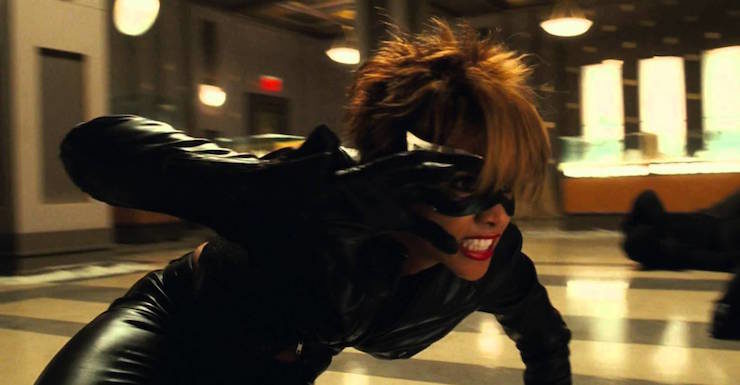
There is a comic book that it does take inspiration from, though, and it’s The Crow. Both this movie and that 1994 film (along with its three virtually identical sequels) share those story beats with the Catwoman portion of Batman Returns. But where Returns had a whole bunch of other things going on (not to mention Michelle fucking Pfeiffer), and where The Crow at least had some serious style, this movie has nothing. (Though, amusingly, Michael Massee is in both The Crow and Catwoman.) Halle Berry is a very good actor, but while she didn’t deserve the Razzie, she is very flat in this movie. The performance is all surface. She goes through the (literal) motions of acting cat-like, but only sometimes. She acts like a badass, but only sometimes. We get no sense of the pain she suffers, no sense of any kind of agony. She’s shy and retiring, but it’s nowhere near the crippling social anxiety that Pfeiffer portrayed in Kyle.
Worse, the script doesn’t commit to the transformation. Even after she’s resurrected, she still acts just like Patience Phillips sometimes, and Catwoman other times. There’s not enough depth of performance of either one to really make into a proper split personality, it’s just different facial expressions. And while Berry does the cat-like movements well when she’s called upon to do so, she’s only so called sometimes. It’s just a maddening performance, one that refuses to commit.
One of the reasons why The Crow and Batman Returns worked is that Eric Draven and Selina Kyle were completely transformed into the forces of vengeance. Patience Phillips is still mostly Patience Phillips, except when she’s Catwoman, kinda.
The “surprise” that Laurel is the real bad guy is less of one because Hedare is played by some French dude and Laurel is played by Sharon bloody Stone—of course Stone’s character is the bad guy! And her motivations are poorly explicated. Why is she so willing to commit murder to cover up the problems with the face cream? Why commit the worst possible felony when you can just, I dunno, do a little more R&D and not make a face cream that will open you to all kinds of lawsuits down the line? It might have been cool to give Laurel an empowerment agenda, wanting to make women physically stronger than men, thus negating that particular advantage that the male of the species has. However, we never get that, we just get Stone being evil. Snore.
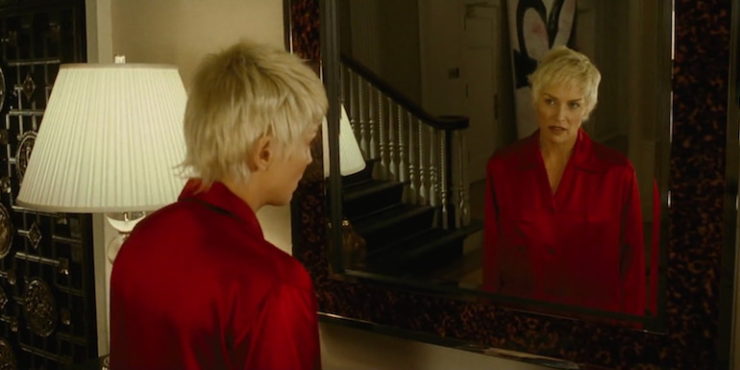
And then there’s Benjamin Bratt, who looks very pretty but, as usual, brings no depth to his character. I first saw Bratt on Law & Order, and I thought he was a decent actor, but everything I’ve seen him in since made me realize that standing next to Jerry Orbach’s magnificence was making him look better than he was.
Ultimately, though, the main culprit is director Pitof, whose direction is, bluntly, awful. The action is poorly visualized, the performances are lifeless and one-dimensional, and the look of the movie is bland as hell. Pitof’s background is visual effects, so you’d think he’d lens a better feast for the eyes than this irritatingly bright movie.
Is it the worst superhero adaptation ever? Not really. While it bears no resemblance to the comics character, it’s very much a sequel to Batman Returns, as it’s taking its cues from that version, and gives Catwoman a history that could be interesting in a better movie. The movie’s failures are directly related to a script that goes through the motions and does nothing interesting with the concept, a director who gives us nothing visually or performance-wise to sink our teeth into, and actors who don’t go past the surface of their characters.
Next week, we’ll look at another movie that (a) has some serious miscasting but (b) also isn’t anywhere near as bad as everyone says it is, the movie Constantine.
Keith R.A. DeCandido is one of the author guests at Balticon 52 this weekend in Baltimore, Maryland. He’ll be spending lots of time at the eSpec Books table hawking his wares (most notably the re-releases by eSpec of Dragon Precinct, Unicorn Precinct, Goblin Precinct, and Tales from Dragon Precinct), and he’ll also be doing panels and things. His full schedule is here.










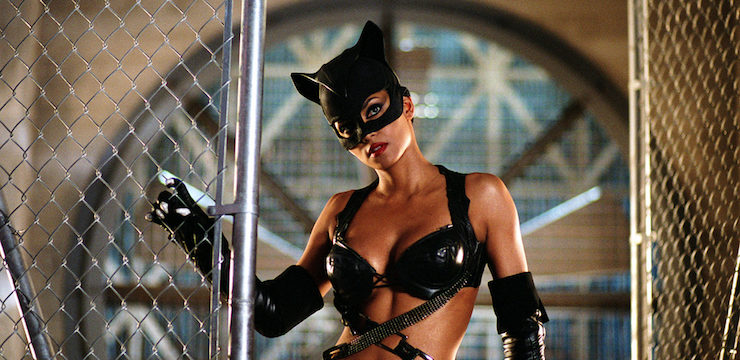
I couldn’t make it through this movie. What I saw wasn’t as bad as, say, the last Batman movie before Nolan took over, but it still couldn’t keep my interest. And I’ve sat through multiple showings of “Yor, Hunter from the Future”.
You’re crazy, Keith. It’s just as bad as everyone says it is. Worse, even. It’s one of the worst—if not THE worst—movies I’ve ever suffered through.
People say this movie is bad? We must not travel in the same circles. I think there was a previous article on Tor about Constantine and pretty much everyone agreed it was an underrated gem.
I saw this movie on a flight. It was so bad… everyone WALKED OUT!
[rimshot]
I think Halle’s problem throughout all her genre roles is that she can’t get past the costume and just doesn’t give believable performances. She is a great actor and has the hardware to prove it, but it seems when she has the costumes on, she can’t fully believe it herself.
(Also, Gotham’s Catwoman is Camren Bicondova not Bioncodova)
Halle Berry was really sexy in this movie. That’s pretty much the only thing it has in its favor, and to an extent it seems like the main purpose the film was made to serve. They didn’t seem to put much effort into anything beyond making their star as sexy as they could. So I find it very watchable in that sense, but I can take or leave everything else about it.
I do think it’s mildly clever that they coped with their inability to do a Michelle Pfeiffer Catwoman movie by retconning Pfeiffer’s Selina into one of many inheritors of the Catwoman mantle. It’s interesting from a structural standpoint how they manage to clue the attentive viewer in that this is supposedly an in-universe spinoff from Batman Returns without ever explicitly referencing anyone or anything from the Batman movies.
@2
You’ve clearly never seen either “Ice Pirates” or “Spacehunter:Adventures in the Forbidden Zone”
Maybe we can get KRAD to do a “Worst Genre Movies of the 70s/80s”.
@7, those two movies are awesome, you shut your mouth!
I mean, they’re terrible, of course, but I have a soft spot for them.
The novelization, by Elizabeth Hand, was actually a pretty decent read.
Oh man, have to disagree. Catwoman is really as bad as people say it is, and if it’s not the worst superhero adaptation ever it’s at least a contender. When this one hit, along with The Hulk and Daredevil, I saw it and cut it slack and wanted so badly to like it. It is just a steaming dumpster fire of a movie. The fact that it is such a garbage film despite having adequate actors and cinematography is a mark against it for me. So bad.
I have to join the chorus of people saying that yes, this is indeed as bad as most people make it out to be.
It’s not as dull as Elektra, but from a technical viewpoint and a narrative perspective it’s even worse. The very weak link to Batman Returns feels like an afterthought, since they needed a trigger to change the title character into her new being, but even all the links to Returns in the world couldn’t have saved this any more than they saved its actual direct sequels Forever and & Robin. And personally, while I realize others will certainly disagree and are welcomed to do so, Catwoman’s costume makes her look just laughable and ridiculous instead of sexy, as was the intention. Just because Halle Berry was showing more skin off than Michelle Pfeiffer it didn’t make her any sexier (as a matter of fact Berry was way sexier as Storm, too).
The villainess is a complete failure, with Sharon Stone putting as much effort into an already shallow as written role as Marlon Brando put in his Jor-El. The romantic interest is another bore and, much like Ebert said in his day, lacks any actual chemistry with Berry; I’ve never been much of a Cat-Bat shipper (I’ve a hard time fully buying the obsessed Wayne ever putting any woman over his crusade in the long run, although I’ve liked his relationships with the likes of Phantasm and Shondra Kinsolving well enough), but this movie never reached the amount of sexual tension the original characters had by any long shot.
Has anyone seen Pitof’s first feature, Vidocq? It is totally crazy – super-kinetic, camera angles from everywhere, constantly cutting, villain in a mirror mask, and the older, dumpy Gerard Depardieu as an action hero, declared dead at the very start. It wasn’t exactly a successful experiment (it was a very early digital shoot, with some advanced special effects processing), but it sure stands out.
Catwoman, not so much. I agree that it isn’t as bad as people say, but I liked Elektra.
Look, I admit the movie is really bad, but it’s not even the worst film in this rewatch. I’d rank Son of the Mask, Howard the Duck, the 1990 Captain America, the 1994 Fantastic Four, and all three Crow sequels below this, at the very least…..
.—Keith R.A. DeCandido
I’ve been saying for years that the basic concept of Catwoman is pretty solid. It’s a shame the execution sucked so badly. (I’m with Krad that it isn’t as bad as people make it out to be, but that’s pretty much akin to saying that Pneumonia is better than Pneumonic Plague. It might be factually accurate but that doesn’t mean you want to go out and get Pneumonia!)
I would love to see this idea (not the film but the idea) rebooted and given another go – just make it really, REALLY explicitly clear that it isn’t intended to be any part of the Bat-franchise next time (because I’m fairly sure that at least some of the opprobrium this film gets is because it isn’t really in the Bat-franchise and people think it ought to be). And get a writer who can put together a coherent story. And maybe don’t make the villain quite so obvious in the casting if you’re shooting for Surprise!Villain!Twist at the end.
@14/Athersgeo: But it was meant to be implicitly part of the Batman series, as I said. That’s why they took Selina’s origin from Batman Returns and made it a legacy passed down from woman to woman, and implied that Selina had been an earlier bearer of the mantle. They couldn’t come out and make it explicit, apparently, but that does seem to be what they intended.
As for the premise and story of the film, I find it ironic that, even though it’s a Catwoman movie, it basically uses the same plot device as Batman: The Animated Series‘s Clayface origin, with an evil cosmetics executive covering up the horrific side effects of their heavily hyped new beauty cream. Although Roland Daggett’s Renuyu in “Feat of Clay” made the face and skin more pliable, not less.
@13 Yeah, I hear you on the comparisons. Like I said if it’s not the worst it’s a contender. Although I would say that Howard, Captain America and Corman’s Fantastic Four were at least somewhat entertaining to watch ‘crash and burn’. Catwoman I just can’t think of anything good to say about it other than ‘they remembered to turn the camera on’ or ‘the actors were human’.
I’ve never seen it, I have no intention of seeing it, but I just want to express my appreciation again to krad for throwing himself in front of train wrecks like this. God it sounds dreadful, and when you’re saying “at least it’s better than Howard the Duck” … my god what praise!
@15 The problem of copying the “Clayface” episode plot, of course, is that that was one of the standout episodes of such a great show, so the plagiarism is that much easier to catch!
@krad I think that the debate on how bad the movie is is less about its absolute worth and more the comparison to Constantine. As I’m sure will be said next week by many, that one is a good film but a poor adaptation – this is neither a good film nor a good adaptation
@18/bhaughwout: Plagiarism is a serious charge that shouldn’t be thrown around recklessly. Laypeople always assume that any similarity between two stories “proves” direct imitation, but the truth is pretty much the opposite. The fact is, different creators accidentally hit upon parallel ideas constantly. We’re all working from the same collective cultural pool of ideas and tropes, and there are only so many viable ways to put a story together, so different writers working with the same characters or genre will inevitably end up overlapping each other’s ideas from time to time. It’s hard to avoid, and it’s an ongoing nuisance for creators, so as a rule, creators actively try not to copy pre-existing ideas. So that kind of similarity is usually an indication that the later creator was not aware of the earlier work, because they would’ve done something different if they’d known about the parallel.
Besides, when you’re talking about a long-running series that’s told a large number of different stories, that greatly increases the probability that any given movie will have coincidental similarities to at least one of its installments.
Granted, the makers of Catwoman weren’t all that creative, so I wouldn’t put it past them to copy other people’s work. But I also wouldn’t give them credit for enough Batman savvy to even know about B:TAS or “Feat of Clay.” More likely, their thought process was rooted in good old-fashioned sexism. Since their heroine was played by a woman acclaimed for her superlative beauty, they figured her enemy had to be a woman and their conflict had to center on beauty. Hence, her enemy had to be an evil cosmetics exec, therefore she had to be covering something up about a dangerous beauty product. Throw in some token commentary about the price women pay for their obsession with staying ageless and unchanging, yada yada yada.
@12 — Yes, I saw Vidocq many, many years ago (I think I found it via some weird six-degrees sequence that began with Brotherhood of the Wolf, maybe?); should probably dig out the disc and throw it into the player again one of these days.
Apparently Rogers was giving a screenwriting lesson and said “Every story can be summed up in one word. If you lose track of where a scene should be going, just go back to that one word and you’ll know. So for `The Godfather’ the word is ‘family’. For ‘The English Patient’ the word is ‘loss’.”
One of the students puts his hand up and says “You worked on ‘Catwoman’. What was the one word for that?”
Rogers thinks and says “‘Mortgage’.”
18.
In Hollywood plagiarism is the sincerest form of flattery. :)
@21,
One of Gina Barreca’s Facebook posts noted that she “doesn’t have a muse; she has a mortgage and a deadline.” This may not have originated with her.
—
Superheroes, action, adventure, and sexy costumes are certainly no bars to a great movie, but the perception that there is a major audience for whom superheroes, action, and sexy costumes are the only requirements for massive sales certainly is.
Keith,
Watch this?
Never have.
Never will.
Mindy: hey, I only watched because it’s part of this rewatch and they pay me. *laughs*
—Keith R.A. DeCandido
All of a suddenly skintight leather isn’t sexy enough? Seriously?
@27/roxana: All I know is, I’d rather look at Halle Berry’s skin than some poor dead animal’s.
Well obviously there are people who want to look at Halle Berry’s skin. Fact is skintight leather isn’t very practical. How about a nice Jersey knit?
Uh, they can make fake leather. Doesn’t have to be a real animal’s skin.
@30/Will: Obviously, but it’s beside the point of the joke.
KRAD, do you seriously think it’s not as bad as Howard the duck? I mean, I hated that movie, but at least I actually managed to finish watching it… in one sitting no less. Unlike this heap of snoredom.
And Constantine is a good movie, it just isn’t anything like the comics.
Berthulf: As I said in my review, “the only thing watching Howard is good for is to destroy your soul and remove your ability to feel joy and happiness.” By contrast, Catwoman is just a crummy movie……………. :)
—Keith R.A. DeCandido
This movie, man… I saw it for free, and I still wanted my money back.
One thing I did not remember is that she had a good Catwoman outfit before the midrif baring, cat ears half-mask one…
@3 – Austin: Yes, a lot of us say Constantined sucked.
@21 – ajay: LOL!
@25 – krad: Mortgage. :)
Belated, but the lack of an even vaguely coherent evil plan is a major issue with the film. We’re not asking for a “sensible” plan necessarily, just some sort of awesome or melodramatic plan. A friend of mine had assumed, based on the first half of the movie, a much more reasonable plot that the writer could have switched to with no need for any different plot beats: of course this deadly cream will ruin the company, and of course it would be madness to release it, but that’s the point. The wife hates the husband, and the best way she can imagine to destroy him is to cover up the problem and let a massive public health crisis be named after him, ruining his name and legacy forever. Catwoman is going to expose this too early when it’ll be laughed off as a product under development, and that’s why we’re gonna have a big fight.
Instead, we get yes, we’ll release this and scar everyone and make tons of money. Right.